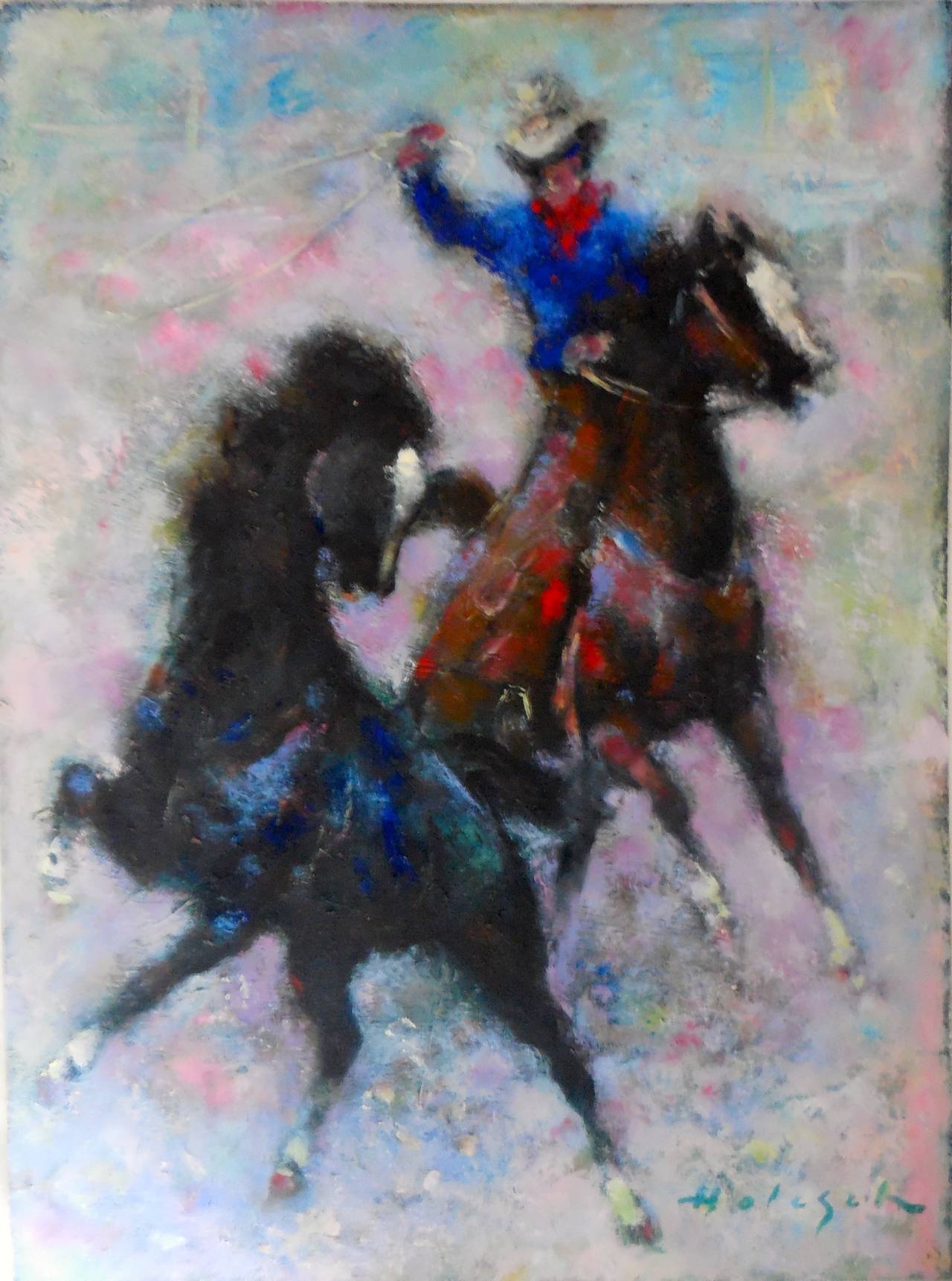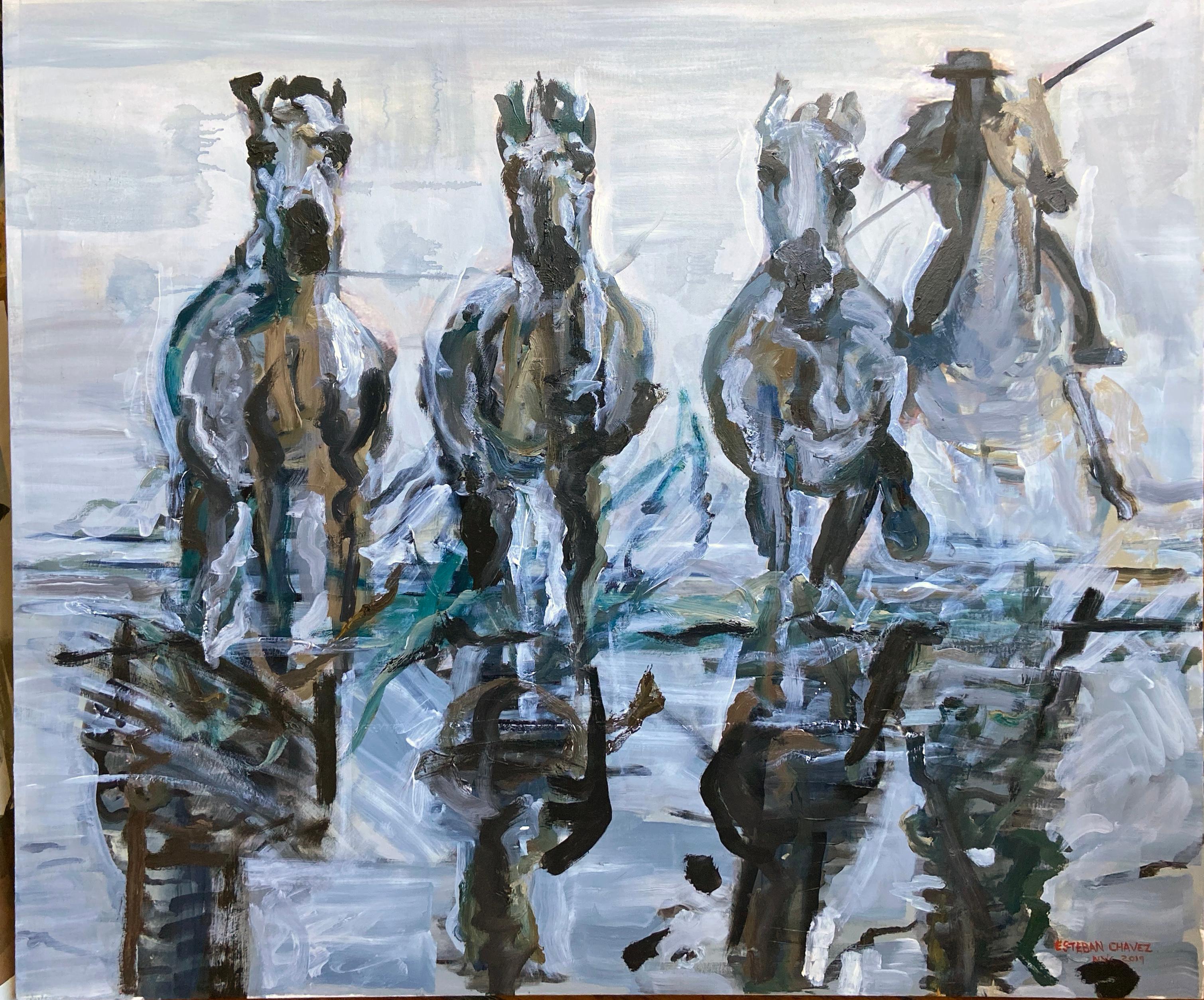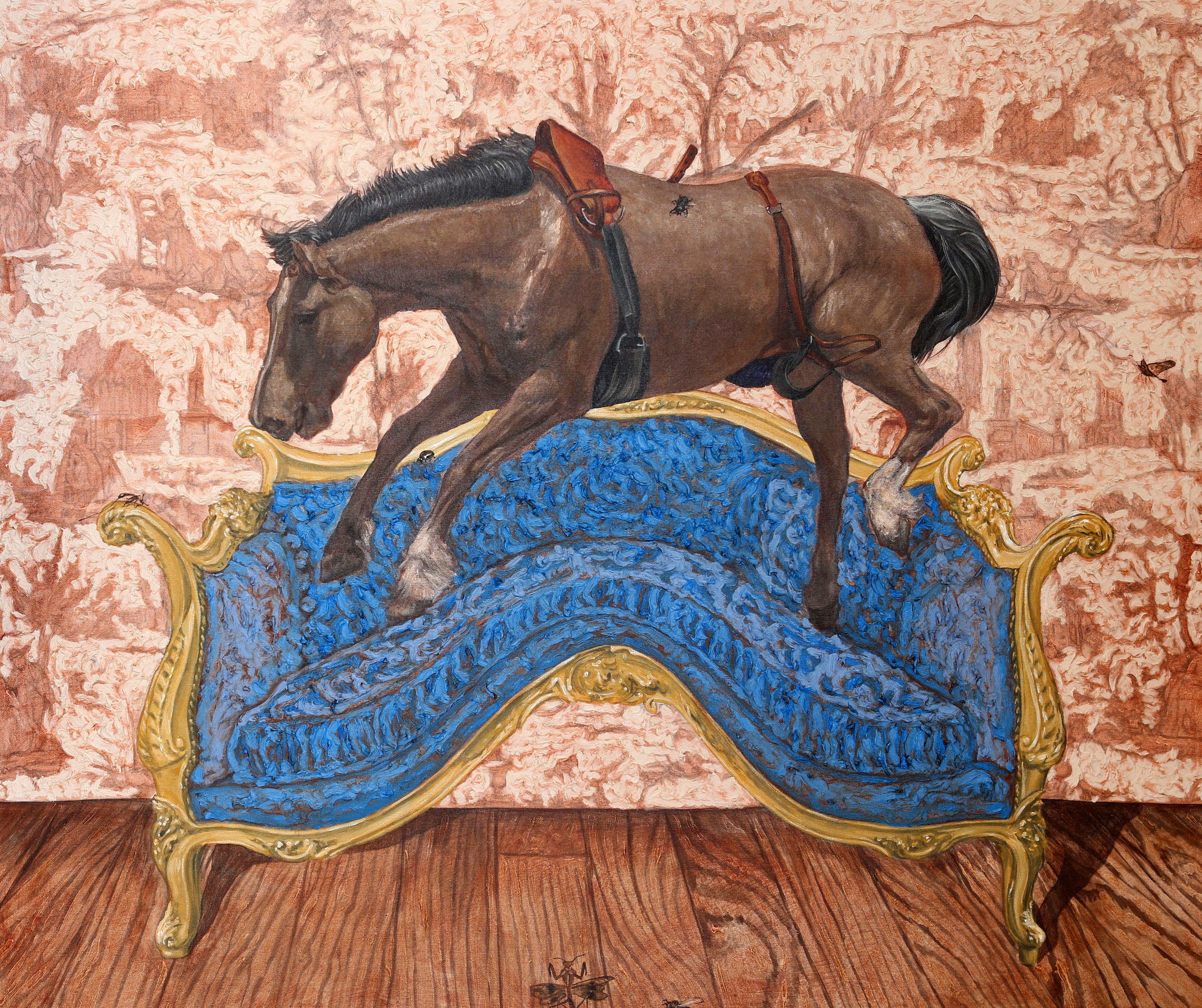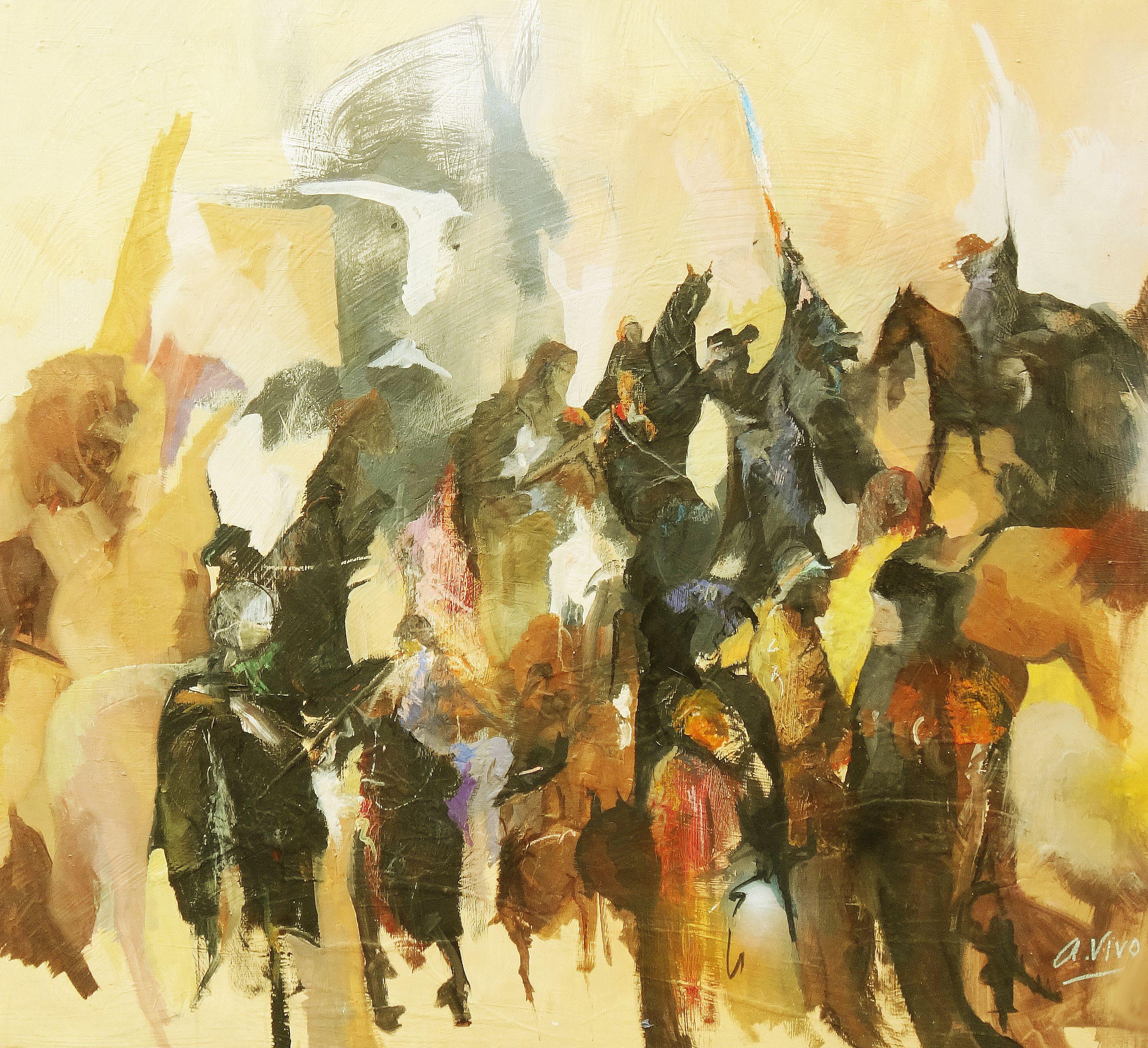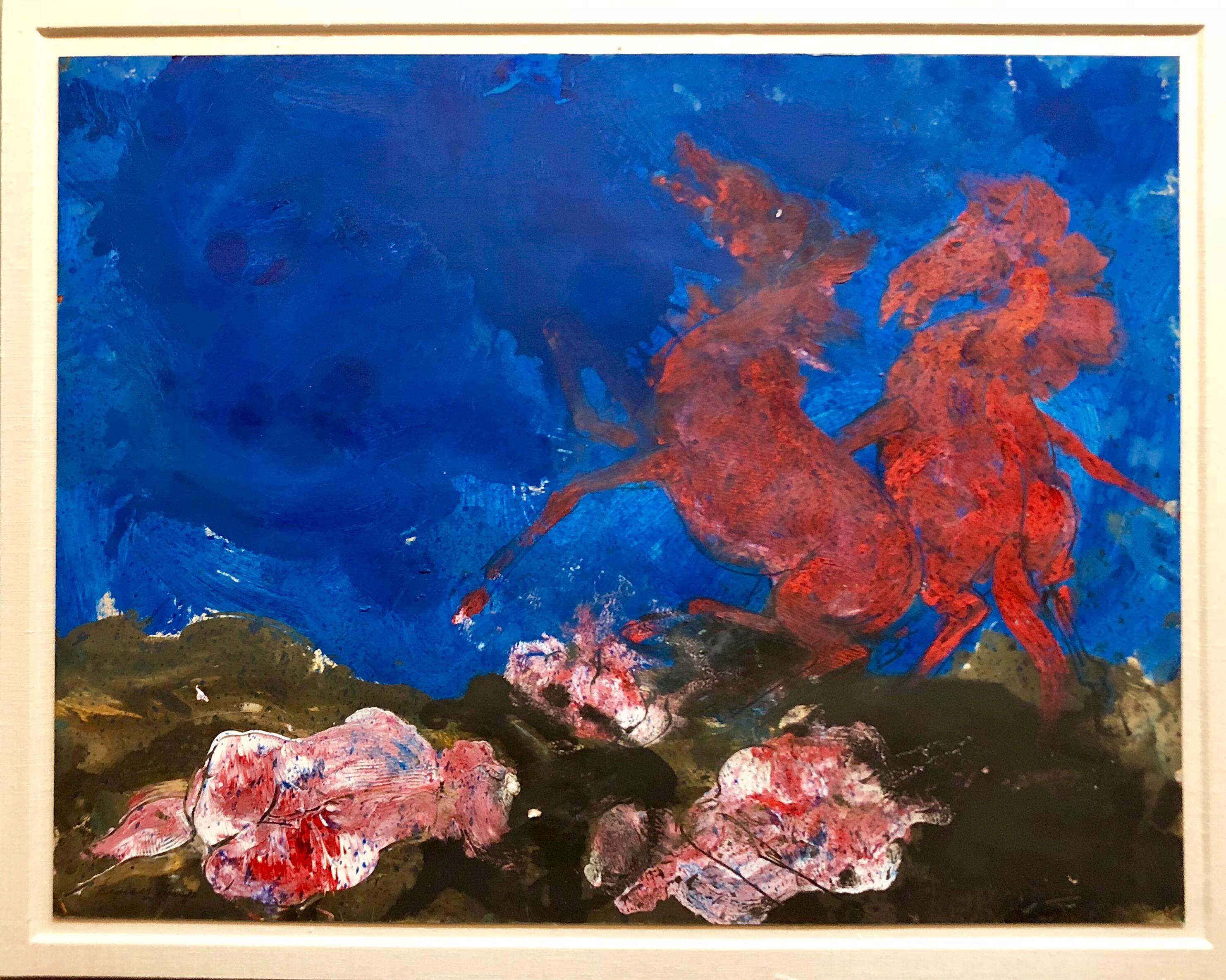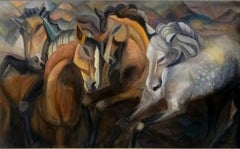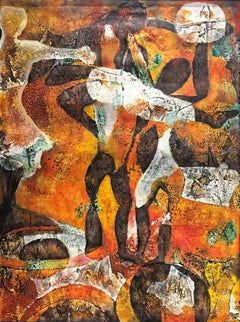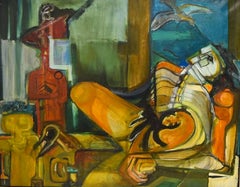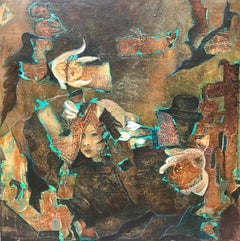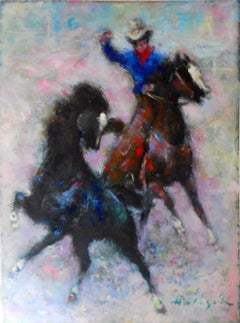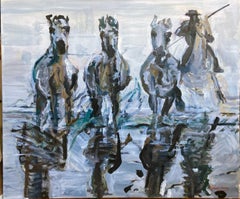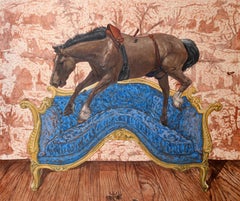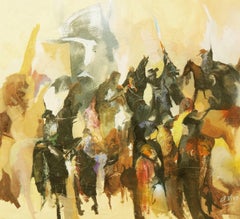Items Similar to Horse Traners
Want more images or videos?
Request additional images or videos from the seller
1 of 5
Umberto RomanoHorse Traners1952
1952
$1,853
$2,85034% Off
£1,402.90
£2,157.7234% Off
€1,624.72
€2,498.8934% Off
CA$2,622.42
CA$4,033.4034% Off
A$2,938.17
A$4,519.0434% Off
CHF 1,527.98
CHF 2,350.1034% Off
MX$35,598.12
MX$54,751.5534% Off
NOK 19,467.09
NOK 29,941.2834% Off
SEK 18,173.20
SEK 27,951.2234% Off
DKK 12,128.19
DKK 18,653.7234% Off
About the Item
UMBERTO ROMANO
"HORSE TRAINERS"
OIL ON PANEL, SIGNED
AMERICAN, DATED 1952
23.74 X 35.75 INCHES
Born: 1905 - Naples, Italy
Died: 1984 - New York City
Known for: Genre, portrait, and figure painting, illustration, mural
- Creator:Umberto Romano (1905 - 1984, American, Italian)
- Creation Year:1952
- Dimensions:Height: 23.75 in (60.33 cm)Width: 35.75 in (90.81 cm)Depth: 0.5 in (1.27 cm)
- Medium:
- Movement & Style:
- Period:
- Framing:Framing Options Available
- Condition:
- Gallery Location:Los Angeles, CA
- Reference Number:1stDibs: LU3910484042
About the Seller
5.0
Vetted Professional Seller
Every seller passes strict standards for authenticity and reliability
Established in 1972
1stDibs seller since 2011
409 sales on 1stDibs
Typical response time: 6 hours
- ShippingRetrieving quote...Shipping from: Edgewater, NJ
- Return Policy
Authenticity Guarantee
In the unlikely event there’s an issue with an item’s authenticity, contact us within 1 year for a full refund. DetailsMoney-Back Guarantee
If your item is not as described, is damaged in transit, or does not arrive, contact us within 7 days for a full refund. Details24-Hour Cancellation
You have a 24-hour grace period in which to reconsider your purchase, with no questions asked.Vetted Professional Sellers
Our world-class sellers must adhere to strict standards for service and quality, maintaining the integrity of our listings.Price-Match Guarantee
If you find that a seller listed the same item for a lower price elsewhere, we’ll match it.Trusted Global Delivery
Our best-in-class carrier network provides specialized shipping options worldwide, including custom delivery.More From This Seller
View AllArt Deco Horses
By Reza Afrookhteh
Located in Los Angeles, CA
Reza Afrookhteh begun studying art seriously at age 15 and was studying at institute of art where he graduated with highest honor. He also studied priv...
Category
Early 2000s Cubist Figurative Paintings
Materials
Canvas, Oil
Price Upon Request
ENCOUNTER
By Lorena Villalobos
Located in Los Angeles, CA
LORENA VILLALOBOS
"ENCOUNTER"
OIL ON CANVAS, SIGNED
COSTA RICA, DATED 2005
39 X 29 INCHES
Lorena Villalobos
Villalobos was born in Costa Rica in 1961.
She studied Fine Arts at...
Category
Early 2000s Modern Abstract Paintings
Materials
Canvas, Oil
Abstract Figures
Located in Los Angeles, CA
UNIDENTIFIED
"ABSTRACT FIGURE"
OIL ON CANVAS, UNSIGNED
AMERICAN, C.1960S
27.5 X 35 INCHES
Fine Condition
Category
1860s Abstract Abstract Paintings
Materials
Oil
$950 Sale Price
51% Off
Inter-personal Spaces
By Lorena Villalobos
Located in Los Angeles, CA
Lorena is a spontaneous creator who continually challenges herself with fresh outbursts of expression in any medium that she approaches; oil on canvas, acrylic, drawing, woodblock ca...
Category
2010s Contemporary Figurative Paintings
Materials
Acrylic
Abstract Composition
Located in Los Angeles, CA
Ms De Pinna was part of the Provincetown modernist art movement and was a student of legendary artist/teacher Hans Hoffman.
Vivian (Foster) De Pinna was a su...
Category
1960s Abstract Expressionist Abstract Paintings
Materials
Oil
Abstract with Text
By Ronald Ahlstrom
Located in Los Angeles, CA
RONALD AHLSTROM
"ABSTRACT IN WITH TEXT"
ACRYLIC AND COLLAGE ON CANVASBOARD, SIGNED
AMERICAN. C.1970
18 X 24 INCHES
Ronald Ahlström
1922-2012
Born in Chicago, Ronald Ahlström graduated from the School of the Art Institute, where he frequently exhibited his collages and paintings in the Chicago and Vicinity exhibits of the 1950s and 1960s.
He also showed at Exhibition Momentum in the ’60s, and was selected for the Corcoran Biennial. Together with his colleagues and fellow-abstractionists Robert Nickle, Morris Barazani, Harry Bouras, George Kokines, and George Waite, he exhibited at McCormick Place in an independently produced survey of contemporary Chicagoans, circa 1962, under the banner 12 Chicago Artists.
An adept and sensitive painter, Ahlström’s most personal work is as an abstract expressionist collage maker. Using strips of paper, sometimes weathered and beaten into rough hewn surfaces, he creates immaculately layered, lively, gestural compositions.
Education:
Art Institute of Chicago
University of Chicago
DePaul University
Exhibitions:
Art Institute of Chicago Annuals, 27 Corcoran Biennial in Washington DC, 12 Chicago Artists, 50 Chicago Artists European Exhibit at the US Information Agency, College and Construction, Hyde Park Art Center, Chicago, Chicago Artist’s 1963, Tacoma Art Museum, Washington, Henry Gallery, University of Washington, Seattle, 50th Northwestern Annual, Seattle Art Museum, Chicago Invitational, University of Illinois, and many more.
One Man Exhibits:
Rockford College, Rockford Il.
Barat College, Lake Forest Il.
Rodger Wilson Gallery, Chicago, Il.
Touchstone Gallery, New York, NY.
Joseph Faulkner, Main Street Galleries, Chicago, Il.
Zriny Galleries, Chicago Il.
Awards:
Clyde Carr Prize, Art Institute of Chicago
William H. Bartels Prize, Art Institute of Chicago
James Broadus Clark Prize, Art Institute of Chicago
Alumni of Art Institute Prize
Singer and Sons Prize, Navy Pier, Chicago
Abel Fagan Prize, Festival of Fine Arts, Lake Forest, Il.
Ford Foundation Purchase Prize, Seattle, Wa.
Collections:
Art Institute of Chicago
Barat College
Tacoma Art Museum, Wa.
Phibrook Art Center, Tulsa, Ok.
Blue-Cross Collection, Chicago, Il.
Atlantic Richfield Collection
Illinois Bell Telephone Collection
Container Corporation of America Collection
Gutenberg Museum, Mainz, Germany
Playboy Enterprises, Chicago, Il.
Smithsonian Institution, Washington, DC.
Art Collection 1st National Bank, Chicago
And many private collections
Publications:
Who’s Who in America
Who’s Who in American Art
Who’s Who of Midwest Art...
Category
1970s Abstract Abstract Paintings
Materials
Acrylic
$435 Sale Price
54% Off
You May Also Like
Western Scene (Cowboy on Horseback)
By Denes de Holesch
Located in Surfside, FL
This is an oil on artist board (unframed) by the important Hungarian-born and internationally celebrated Denes de Holesch (1910-1983).
Denes de Holesch was an international equestrian artist. His works have been exhibited all over the world, including in New York, Beverly Hills, Boston, Chicago, Paris, Mexico City, Montreal, Tokyo, Sydney, and Madrid. His horse paintings fall into one of seven themes, including polo, cowboys, circus, rodeo, hunt, bull-fight, race-course and running free. His mastery of the subject has been compared to that of Picasso, Delacroix and Franc Marc.
1910 Denes Dezo George de Holesch was born on 9 February, 1910 at Banska-Bystrica, Northern Hungary. He was the third child and youngest son of Hugo de Holesch, an architect and Margit, nee Wagner. Many generations of the de Holesch family had worked as professional architects. He studied at the Hungarian Academy of Fine Arts in Budapest on a scholarship. Early in his career he traveled to China, Japan, Philippines, Java, Bali and Australia, where his reputation grew rapidly. Here he produced portraits in oils, and lithographs of the Chinese, as well as landscape works in oils,depicting the local countryside, and canal, street and city scenes. His exposure to the arts of the Chinese, with their simplicity of line, greatly influenced his later works. In 1939 he established a studio at Lavender Bay near Sydney. In 1940 he exhibited at the Macquarie Galleries in Sydney. In 1944 he married Joyce Greer, the Melbourne concert pianist. In 1945 the couple moved to New York where his interest in horses grew. He held exhibitions at Gallery Wildenstein, Herve, and FAR Gallery. In 1946 Holesch moved to Montreal where he exhibited at the National Gallery of Montreal. In 1947 he moved to Boston where he continued painting portraits and horses. He exhibited there at the Ehrmann and Vose galleries. Later in the year he moved to San Francisco where he was invited to participate in the "Renoir to Picasso" Exhibition held at the Maxwell Gallery.1946 He moved to Montreal, Canada and exhibited at the National Gallery of Montreal. (Frederic Remington and Charles Russell)
1947 Early in the year he moved to Boston and continued painting portraits and horses. In June, he painted the portrait of Harvard Law School Dean, Erwin N. Griswold, and in October his works were exhibited at Margaret Brown's Galerie Intime, Newbury Street, Boston.
1948 He produced a clay sculpture head of Egon Petri, one of a number of clay sculptures that he produced. He also produced a number of wood carvings. His paintings were chosen for inclusion in a Group Exhibition in the National Gallery of San Francisco, and in the important and prestigious 'Renoir to Picasso' Exhibition held at Maxwell's Galleries, 372 Sutter Street, San Francisco.
1953 His works were included in a Group Impressionists Exhibition held at the Ohana Gallery, London
1954 He travelled to New York, where he was commissioned to paint Herbert Gasser, Nobel Prize Winner in Biochemistry.
1955 He returned to England, and then travelled to Paris to exhibit works in the Galerie Marcel Lenoir.
1956 He again returned to New York to work on portrait commissions and for exhibitions of his works, mainly of horses. These exhibitions were held in New York, Boston, San Francisco and late in the year at the Galleries of Frank J. Oehlschlaeger at 107 East Oak Street, Chicago. During this year, visits with his family to Ringling Circus and to a rodeo in Tucson, Arizona must have impressed him greatly, for images of these events soon appeared on his canvases. His work was greatly admired by Hollywood film- stars, such as Ann Rutherford and Burt Lancaster, and David Niven purchased one of the horse paintings to give as his wedding present to Grace Kelly on her marriage to Sovereign Prince Rainier III of Monaco.
1959 The prints of 'Courtship' and 'Chargers' were produced. It has been estimated that close to a million copies of his prints were sold over the next ten years, with 'Courtship' being advertised by Stern's Book Dpt. on 5th Avenue, New York along with prints by Picasso, Degas, Goya, Modigliani, Renoir and Van Gogh.
1960 He moved to Antibes, on the French Riviera in the South-East of France. An exhibition of his works was held in the Galerie des Etats-Unis, Cannes and his works were now permanently exhibited at Galerie Madsen, Rue St. Honore, Paris and Galerie Davis, Place Vendome, Paris.
1961 Known to Picasso, he was invited to attend a special bull-fight held in the South of France, which was organized for Pablo Picasso's 80th birthday.
1975 He moved from Voulangis to Castelfontana in the Dorf Tirol overlooking Merano, Italy. He remained there for close to a year and exhibited his works in a group exhibition in Merano in which works by Salvador Dali and Annigoni were also displayed.
1979 He returned to the old farmhouse at Voulangis. During this time he painted the portrait of Pope John Paul II.
1989 a catalog and biography of Holesch entitled Holesch Horse Paintings 1910-1983 was published by Andrew Mackenzie...
Category
20th Century American Realist Figurative Paintings
Materials
Oil, Board
Four Horses, oil painting
Located in Brooklyn, NY
Expressionistic gestural painting with oil to depict the primal energy of brood mares being herded along the sea coast.
Category
Early 2000s Contemporary Animal Paintings
Materials
Oil
American Contemporary Art by Carlos Gamez de Francisco - Equestrian Style
Located in Paris, IDF
Oil on canvas
Carlos Gamez de Francisco is an American artitst with Cuban origins born in 1987 who lives and works in Fort Myers, FL, and Louisville, KY. He has received numerous aw...
Category
2010s Contemporary Figurative Paintings
Materials
Oil, Canvas
4477 Brave horsemen heroes old, Painting, Oil on Canvas
By Andres Vivo
Located in Yardley, PA
Many referencial heroes like Napoleon, Garibaldi,Don Quijote ...cowboys,explorers, etc who did on horseback. :: Painting :: Surrealism :: This piece comes with an official certifica...
Category
2010s Surrealist Figurative Paintings
Materials
Oil
FIGHTING ON HORSEBACK - Italian abstract oil on canvas painting. A. Pragliola
By Alfonso Pragliola
Located in Napoli, IT
Fighting on horseback -Modern - Alfonso Pragliola Italia 2014 - Oil on canvas cm.60x40.
Laquered wooden frame.
Category
2010s Abstract Abstract Paintings
Materials
Canvas, Oil
American Neo Expressionist "Wild Horses" Modernist Oil Painting
By Robert Beauchamp
Located in Surfside, FL
Robert Beauchamp (1923 – March 1995) was an American figurative painter and arts educator. Beauchamp's paintings and drawings are known for depicting dramatic creatures and figures with expressionistic colors. His work was described in the New York Times as being "both frightening and amusing,". He was a Guggenheim Fellow and a student of Hans Hofmann.
Robert Beauchamp was born in Denver, Colorado in 1923. He had three brothers and three sisters, and the children were orphaned by both parents by the time Beauchamp was three. The family grew up impoverished due to the Great Depression, living in a community house with other families. As a child he dabbled in art but it wasn't until high school that he began taking art classes. When not creating art he also played sports; football and basketball, and enjoyed chemistry and geology.
He was told he was good at drawing, and replaced study hall classes with art classes, receiving instruction and inspiration from a Welsh teacher named R. Idris Thomas. While in high school Beauchamp would go, every Monday, to the public library and a local museum where he would read books about art; specifically French painting, as assigned by Thomas. Beauchamp absorbed the tenets of European Modernism and American Abstract Expressionism—with which he eventually broke. While abstraction, with its focus on color and form, underlies his compositions, he filled canvas and paper with psychologically acute portraits of himself and others, nudes, animals, and objects of all kinds. Beauchamp would spend upwards of four hours a day in the art room and eventually won the Carter Memorial Prize, which provided a scholarship to the Colorado Springs Fine Arts Center. At Colorado Springs he studied under Boardman Robinson, painting landscapes in nature.
Beauchamp eventually joined the Navy and then returned to Colorado Springs to continue his studies. Traveling the world as an Armed Guard, he spent a year and a half at sea and the rest of the three years in San Francisco. Seeking to make money, and to follow his love for a girl, Beauchamp decided to attend Cranbrook Academy of Art from 1947–1948. There he studied pottery, believing one could "make more money selling pots than you could selling paintings." He described his experience at Cranbrook as intimidating and claustrophobic, and eventually switched to sculpture before switching to painting.
Beauchamp moved to New York City in the early 1950s and was involved in the Tenth Street galleries, which provided outlets for more experimental artists and the second generation of abstract expressionists. Despite his involvement with 10th Street and friendships with abstract artists, abstract art never interested in him. He showed at numerous galleries in New York and Provincetown, socializing with gallery owners, artists and collectors. His first exhibition was at the Tanager Gallery in New York, he also showed during the 1950s at the Hansa Gallery. In New York and Provincetown he studied under Hans Hofmann Eventually he felt that abstract expressionism became dull and stalemated.
During the 1960s he showed at the Green Gallery. C. 1960 he was awarded a Fulbright Award allowing him to travel to La Romola, Italy. He traveled frequently to cities such as Rome and worked constantly. Beauchamp returned to the states and lived in Provincetown at Walter Gutman's house, who awarded Beauchamp a grant. That year he met his future wife, Nadine Valenti, whom he married in 1967. Beauchamp taught at a variety of schools during his lifetime including Brooklyn College, School of Visual Arts, Cooper Union and the Art Students League of New York during the last fifteen years of his life.
Beauchamp described his drawings as painterly, seeking the spontaneity in an image. He would develop a drawing then a painting, and vice versa. His heavily impastoed paintings, often described as sculptures themselves, came from the pouring of paint from a can, with little planning and constant evolution in the medium upon the canvas. He preferred little planning to his creations, believing that an artists work would become stale and repetitive with constant planning.
He also created large scale works, at times 70 inches long. Beauchamp had little intention of ever selling his large works, preferring to create them due to the slow and intense experience he received from the process. The large drawings he created on the floor, and the smaller works were created on a table. Paintings were created on either the floor or wall and he described his painting process as "splattering", "pushing the paint around," and sponging.
Animals often appear in his paintings, despite a dislike for domestic animals outside of his artistic creations. He called the characters in his paintings as Beauchamps. Some Beauchamps hold meaning, with Beauchamp rarely sharing the meaning behind the symbols and characters. He made up the creatures himself, seeking to emphasize the character of each.
In 2006 the University of Massachusetts Amherst College of Visual & Performing Arts hosted an exhibition of Beauchamp's pieces from the 1960s, curators stated that Beauchamp's work: "effortlessly blends innovative style elements with narrative, descriptive images. One senses equal enjoyment in the manipulation of, and interaction with, color and paint, and the often sudden and unexpected presence of a wasp or a lump of sugar."
included in the important exhibit "Twelve New York Painters." New York: David Findlay Jr. Fine Art with Mary Abbott, Alcopley, Robert Beauchamp, Byron Browne, Charles Cajori, Jim Forsberg, Carl Heidenreich, Angelo Ippolito, Emily Mason, Robert Natkin, Robert Richenburg and Nina Tryggvadottir...
Category
20th Century Neo-Expressionist Abstract Paintings
Materials
Paper, Oil
More Ways To Browse
Dior 1952
Dior Horse
Horse Painting Italian
French Nude Oil Paintings
Social Realism
Master Copy Painting
Miniature City
Unknown Master Painting
Painting Of Sofa
Gold 1976
Theatre Canvas
Antique Painting Girl
Jewish Art Framed
Portraits Of Native Americans
Oil Painting Portrait Spanish
Depression Painting
Jean Michel Basquiat Signed
Oil Painting Conversation
